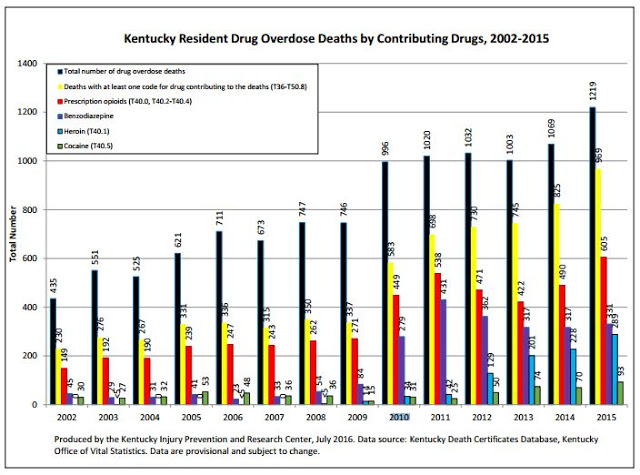Reformulation of OxyContin to make it abuse-deterrent is main reason for shift to heroin and deaths from it, study concludes

Kentucky Health News
The reformulation of OxyContin in 2010 is the main reason for the large increase in heroin overdose in recent years, according to a working paper by the RAND Corp. and the Wharton School of economics at the University of Pennsylvania.
Purdue Pharma released OxyContin as a 12-hour-release opioid for acute or chronic pain in 1996. The original formulation could be easily crushed or dissolved, allowing a person to get the 12-hour dosage all at once, making it ripe for abuse.
In 2007, Purdue Pharma pleaded guilty to misleading consumers about the risk of abuse associated with the drug and paid $600 million in federal fines. In 2010, it released a new formulation of OxyContin that made it “abuse-deterrent,” the first drug to get this designation from the Food and Drug Administration. The report says the formula reduced non-medical OxyContin use as much as 40 percent.
This effort, along with prescription-monitoring programs and “pill mill” laws in Kentucky, Florida and other states, have all been credited with reducing prescription-painkiller deaths, but also the increase in the abuse of “substitute” opiates such as heroin and fentanyl.
 |
| Click on chart to see a larger version of it |
Kentucky has one of the highest OxyContin misuse rates in the nation, at 0.97 percent, says the report. To combat this, the state instigated the Kentucky All-Schedule Prescription Electronic Reporting (KASPER) system and passed a pill-mill bill in 2012 that put additional restrictions on pain clinics and requires people who have certain controlled-substance prescriptions to submit to a regular urine test.
In 2015 Kentucky had 1,220 total overdose deaths, with 605 of them from prescription opioids and 289 from heroin. Five years earlier, 538 of the 996 total overdose deaths were from prescription opioids and only 34 from heroin, according to the Kentucky Injury Prevention and Research Center.
The study, statistically controlling for the monitoring programs and pill-mill laws, concluded that the reformulation of OxyContin played a larger role in the shift to heroin, accounting for “as much as 80 percent of the three-fold increase in heroin mortality since 2010,” the study report says.
Researchers based their conclusion on the differences in heroin deaths after 2010 in states that had differing rates of OxyContin abuse before then.
“States with the highest initial rates of OxyContin misuse experienced the largest increases in heroin deaths,” they write. “Results show that this differential increase in heroin deaths began precisely in the year following reformulation.”
It also found that prior to 2010, there was no correlation between OxyContin abuse and heroin deaths. “Both the levels and trends in heroin deaths were nearly identical across states with high or low initial rates of OxyContin misuse before 2010,” the study report said.
 |
| Graph is from the report, deaths per 100,000 Data from the National Vital Statistics System |
The study found that after the OxyContin reformulation in 2010, prescription opioid abuse and overdose deaths from them in the U.S. decreased for the first time since 1990, but this drop coincided with “an unprecedented rise in heroin overdoses,” which “more than tripled between 2010 and 2014 (from 1.9 to 3.4 deaths per 100,000).” Heroin was responsible for the deaths of more than 10,000 Americans in 2014.
“Each percentage-point reduction in the rate of OxyContin misuse due to reformulation leads to 3.1 more heroin-related deaths per 100,000,” the study report said. It also said the “impact of the reformulation on heroin and opioid deaths largely offset each other, leading to no net reduction in overall overdose deaths.”
The study concluded that “supply-side strategies,” like creating abuse-deterrent drugs, as the FDA is actively encouraging, or making it harder for patients to gain access to them, won’t solve the nation’s drug problems. However, it said they could deter new abuse: “Treating underlying demand may prove to be the more effective strategy for dealing with the current opioid epidemic, particularly because substitutes are readily available.”
Data for the report, published by the National Bureau of Economic Research, is from the National Survey on Drug Use and Health and the National Vital Statistics System.